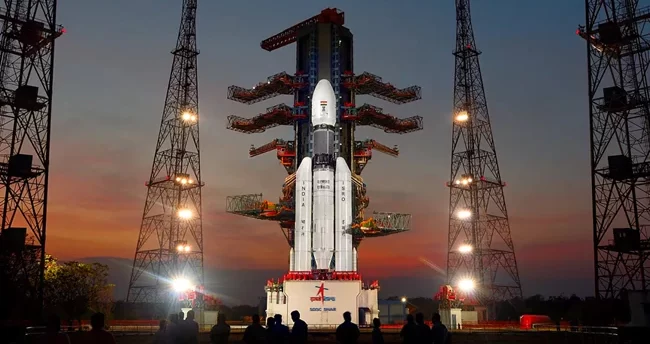Table of Contents
- Space Programme of India started in 1969 with the formation of the Indian Space Research Organisation (ISRO).
- Since its inception in 1969, it has achieved remarkable milestones in space exploration and satellite technology.
- With over 300 satellites launched into space, including notable missions like Chandrayaan-1 (India’s first lunar probe launched in 2008) and Mangalyaan (India’s first interplanetary mission to Mars launched in 2013), ISRO has showcased its prowess in space missions.
- Notably, Mangalyaan, India’s first interplanetary mission to Mars launched in 2013, made India the fourth space agency to reach Mars orbit and the first Asian nation to do so.
- ISRO’s technological advancements include the development of its own satellite launch vehicles such as the Polar Satellite Launch Vehicle (PSLV) and the Geosynchronous Satellite Launch Vehicle (GSLV) series, with the PSLV boasting a success rate of over 90%.
- Through international collaborations and partnerships, ISRO continues to expand its space exploration efforts, focusing on missions to explore Mars, Venus, and the Moon, while also developing satellite technology to address global challenges like climate change and disaster management.
- India’s Space Programme has made significant contributions to various sectors including telecommunications, weather forecasting, agriculture, and disaster management, cementing its position as a prominent player in the global space arena.
Space Centres in India
Satish Dhawan Space Centre
- Satish Dhawan Space Centre (SDSC): Located in Sriharikota, Andhra Pradesh, it serves as the main launch center for the Indian Space Research Organisation (ISRO).
- Originally established in 1971, it was formerly known as the Sriharikota Range (SHAR).
- It was later renamed Satish Dhawan Space Centre SHAR on September 5, 2002, in honor of Dr. Satish Dhawan, former Chairman of ISRO.
Vikram Sarabhai Space Centre
- Vikram Sarabhai Space Centre (VSSC): Situated in Thiruvananthapuram, Kerala, it is the lead center for launch vehicle development activities of ISRO.
- Establishment: Founded in 1963 in Thiruvananthapuram, Kerala, India.
- Named After: Named after Dr. Vikram Sarabhai, the father of the Indian space program.
- Mission: Primarily focused on the design, development, and testing of satellite launch vehicles, including the Polar Satellite Launch Vehicle (PSLV) and the Geosynchronous Satellite Launch Vehicle (GSLV) series.
Space Applications Centre
- Space Applications Centre (SAC): Situated in Ahmedabad, Gujarat, it focuses on the development of payloads for communication, remote sensing, and meteorological satellites.
National Remote Sensing Centre
- National Remote Sensing Centre (NRSC): Based in Hyderabad, Telangana, it is responsible for satellite data acquisition and processing for various applications like agriculture, forestry, and disaster management.
Indian Space Research Organisation (ISRO) Satellite Centre (ISAC)
- Location: Bengaluru, Karnataka, India.
- Responsibilities:
- Designing and developing satellite payloads.
- Integration of satellite subsystems.
- Testing and validation of satellite components.
- Ensuring the reliability and functionality of satellite systems.
ISRO Propulsion Complex
- Location: The ISRO Propulsion Complex (IPRC) is located in Mahendragiri, Tamil Nadu, India.
- Establishment: IPRC was established in the year 2002.
- Role and Responsibilities:
- Liquid Propulsion Systems: IPRC is primarily responsible for the development and testing of liquid propulsion systems for ISRO’s launch vehicles and spacecraft.
- Engine Testing: It conducts testing and evaluation of liquid propulsion engines and stages.
- Component Manufacturing: IPRC manufactures various components of liquid propulsion systems, including engines, valves, and tanks.
- Research and Development: It engages in research and development activities to enhance the efficiency and reliability of liquid propulsion systems.
- Support for Launch Missions: IPRC provides technical support for the integration and launch of ISRO’s launch vehicles and spacecraft.
Historical Background
- Formation of INCOSPAR:
- In the 1960s, the Indian National Committee for Space Research (INCOSPAR) was established.
- Dr. Vikram Sarabhai played a significant role in its formation.
- Transformation into ISRO:
- In 1969, INCOSPAR was reorganized into the Indian Space Research Organisation (ISRO), marking the official beginning of India’s space program.
- First Satellite:
- In 1975, India launched its first satellite named Aryabhata.
- This marked India’s entry into space exploration.
- Important Missions:
- In 1993, India launched the Polar Satellite Launch Vehicle (PSLV), which became one of the world’s most reliable rockets for launching satellites.
- In 2008, Chandrayaan-1, India’s first mission to the Moon, was launched.
- Chandrayaan-1 discovered water molecules on the lunar surface.
- Mangalyaan Mission (Mars Orbiter Mission):
- In 2013, ISRO launched Mangalyaan, India’s first interplanetary mission to Mars.
- Mangalyaan successfully entered Mars’ orbit on its first attempt.
- India became the first Asian country to reach Mars and ISRO the fourth space agency in the world to do so.
- Key Focus:
- ISRO focuses on using space technology for societal development:
- Agriculture: Remote sensing satellites are used to monitor crops and predict agricultural yields.
- Water Management: Satellite data is used for managing water resources and monitoring water bodies.
- Disaster Management: Satellites provide critical information for disaster prediction, mitigation, and relief efforts.
- Future Plans:
- ISRO has ambitious plans for the future:
- Missions to explore Venus and the Sun are in the pipeline.
- Gaganyaan mission, India’s first manned space mission, is planned for the near future.
- International Collaboration:
- ISRO collaborates with various international space agencies:
- Collaborations involve satellite launches, space exploration missions, and sharing of satellite data.
- Collaborative efforts enhance India’s space capabilities and contribute to global space research.
- Conclusion:
- India’s space program, led by ISRO, has evolved significantly since its inception.
- From launching satellites and exploring the Moon and Mars to using space technology for societal benefits, ISRO has made remarkable strides in space exploration.
- With ambitious future plans and international collaborations, ISRO continues to inspire and contribute to advancements in space science and technology.
